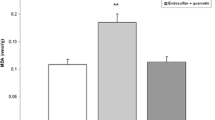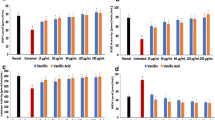Abstract
Due to the implication of oxidative stress in neurodegenerative disorders we decided to investigate the antioxidant properties of acetylsalicylic acid and acetaminophen either alone or in combination. The thiobarbituric acid assay (TBA) and the nitroblue tetrazolium (NBT) assay were used to investigate quinolinic acid (QA)-induced: lipid peroxidation and superoxide anion generation in the rat hippocampus, in vivo. The study also shows, using cresyl violet staining, the preservation of structural integrity of neuronal cells following treatment with acetylsalicylic acid and acetaminophen in QA-lesioned rat hippocampus. Furthermore the study sought to determine whether these agents have any effect on endogenous (QA) formation. This study shows that acetylsalicylic acid and acetaminophen inhibit QA-induced superoxide anion generation, lipid peroxidation and cell damage, in vivo, in the rat hippocampus. In addition these agents inhibit the enzyme, 3-hydroxyanthranilic acid oxygenase (3-HAO), responsible for the synthesis of endogenous QA.




Similar content being viewed by others
References
Aubin N, Curet O, Deffois A, Carter C (1998) Aspirin and salicylate protect against MPTP-induced dopamine depletion in mice. J Neurochem 71:1635–1642
Bautista AP, Spitzer JJ (1990) Superoxide anion generation by in situ perfused rat liver: effect of invivo endotoxin. Am J Physiol 259:G907–G912
Bisaglia M, Venezia V, Piccioli P, Stanzione S, Porcile C, Russo C, Mancini F, Milanese C, Schettini G (2002) Acetaminophen protects hippocampal neurons and PC12 cultures from amyloid beta-peptides induced oxidative stress and reduces NF-kappaB activation. Neurochem Int 41:43–54
Bonilla E, Tanji K, Hirano M, Vu TH, DiiMauro S, Schon EA (1999) Mitochondrial involvement in Alzheimer's disease. Biochim Biophys Acta 1410:171–182
Das UN, Padma M, Sagar PS, Ramesh G, Koratkar R (1990) Stimulation of free radical generation in human leukocytes by various agents including tumor necrosis factor is a calmodulin-dependent process. Biochem Biophys Res Commun 167:1030–1036
Daya S, Walker RB, Anoopkumar-Dukie S (2000) Cyanide-induced free radical production and lipid peroxidation in rat brain homogenate is reduced by aspirin. Met Brain Dis 15:203–209
Dragomir E, Manduteanu I, Voinea M, Costache G, Manea A, Simionescu M (2004) Aspirin rectifies calcium homeostasis, decreases reactive oxygen species, and increases NO production in high glucose-exposed human endothelial cells. J Diabetes Complications 18(5):289–299
Gilad E, Cuzzocrea S, Zingarelli B, Salzman AL, Szabo C (1997) Melatonin is a scavenger of peroxynitrite. Life Sci 60:169–174
Glowinski J, Iversen LL (1966) Regional studies of catecholamines in the rat brain. I. The disposition of [3H]norepinephrine, [3H]dopamine and [3H]dopa in various regions of the brain. J Neurochem 13:655–669
Grilli M, Pizzi M, Menio M, Spano F (1996) Neuroprotection by aspirin and sodium salicylate through blockade of NF-kappaB activation. Science 274:1383–1385
Heyes MP (1996) The kynurenine pathway and neurological disease. Adv Exp Med Biol 398:125–129
Iravani MM, Kashefi K, Mander P, Rose S, Jenner P (2002) Involvement of inducible nitric oxide synthase in inflammation-induced dopaminergic neurodegeneration. Neuroscience 110:49–58
König JFR, Klippel RA (1963) The Rat Brain. Williams and Wilkins, Baltimore MD, 108–114
Kotrly S, Sucha L (1985) Handbook of Chemical Equilibria in Analytical Chemistry, Ellis Horwood Limited, Chichester, UK, p 163
Lapin IP, Mirzaev SM, Rysov IV, Oxenkrug GF (1998) Anticonvulsant activity of melatonin against seizures induced by quinolate, kainite, glutamate, NMDA, and pentylenetetrazole in mice. J Pineal Res 24:215–218
Lowry OH, Rosenbrough NJ, Farr AL, Randall RJ (1951) Protein measurement with the folin phenol reagent. J Biol Chem 193:265–267
Maharaj DS, Saravanan KS, Maharaj H, Mohanakumar KP, Daya S (2004) Acetaminophen and aspirin inhibit superoxide anion generation and lipid peroxidation, and protect against 1-methyl-4-phenyl pyridinium-induced dopaminergic neurotoxicity in rats. Neurochem Int 44:355–360
Mehler AH (1956) Formation of picolinic and quinolinic acids following enzymatic oxidation of 3-hydroxyanthranilic acid. J Biol Chem 218:241–54
Palkovits M, Brownstein MJ (1983) Microdissection of brain areas by punch technique. In: Cuello AC (Ed.), Brain Microdissection Techniques. Wiley, New York, pp 1–36
Paxinos G, and Watson C (1998) The Rat Brain in Sterotaxic Coordinates. Academic Press, New York, pp 41–41
Reiter RJ (1995) Oxidative processes and antioxidant defense mechanisms in the ageing brain. J FASEB 9:526–533
Reiter RJ, Melchiori D, Poeggeler B, Barlow_Walden L, Chuang J, Oritz GG, Acuna-Castrviejo D (1995) A review of the evidence supporting melatonin's role as an antioxidant. J Pineal Res 18:1–11
Rios C, Santamaria A (1991) Quinolinic acid is a potent lipid peroxidant in rat brain homogenates. Neurochem Res 16:1139–1143
Sagar PS, Das UN, Koratkar R, Ramesh G, Padma M, Kumar GS (1992) Cytotoxic action of cis-unsaturated fatty acids on human cervical carcinoma (HeLa) cells: relationship to free radicals and lipid peroxidation and its modulation by calmodulin antagonists. Cancer Lett 63:189–198
Schwarcz R (2004) The kynurenine pathway of tryptophan degradation as a drug target. Curr Opin Pharmacol 4:12–7
Schwarcz R, Koler C (1983) Differential vulnerability of central neurons of the rat to quinolinic acid. Neurosci Lett 38:85–90
Southgate G, Daya S (1999) Melatonin reduces quinolinic acid-induced lipid peroxidation in rat brain homogenate. Metab Brain Dis 14:165–71
Stipek S, Stastny F, Platenik J, Crkovska J, Zima T (1997) The effect of quinolinate on rat brain lipid peroxidation is dependent on iron. Neurochem Int 30:233–237
Stone TW (1993) Neuropharmacology of quinolinic and kynurenic acids. Pharmacol Rev 45:309
Stone TW (2000) Development and therapeutic potential of kynurenic acid and kynurenine derivatives for neuroprotection. TIPS 21:149–54
Stone TW, Perkins MN (1981) Quinolinic acid: A potent endogenous excitant at amino acid receptors in CNS. European J Pharmacol 72:411–412
Teismann P, Ferger B (2001) Inhibition of the cyclooxygenase isoenzymes COX-1 and COX-2 provide neuroprotection in the MPTP-mouse model of Parkinson's disease. Synapse 39:167–174
Zar JH (1974) Biostatistical Analysis, 1st edn. Prentice Hall, Englewood Cliffs, NJ, pp 151–466
Acknowledgements
This study was made possible by a grant from the South African National Research Foundation to Prof. S. Daya. HM and DSM thanks the Medical Research Council (South Africa) for their Post Doctoral scholarships. The authors would like to thank Dave and Sally Morley for technical assistance.
Author information
Authors and Affiliations
Corresponding author
Rights and permissions
About this article
Cite this article
Maharaj, H., Maharaj, D.S. & Daya, S. Acetylsalicylic acid and acetaminophen protect against oxidative neurotoxicity. Metab Brain Dis 21, 180–190 (2006). https://doi.org/10.1007/s11011-006-9012-7
Received:
Accepted:
Published:
Issue Date:
DOI: https://doi.org/10.1007/s11011-006-9012-7




